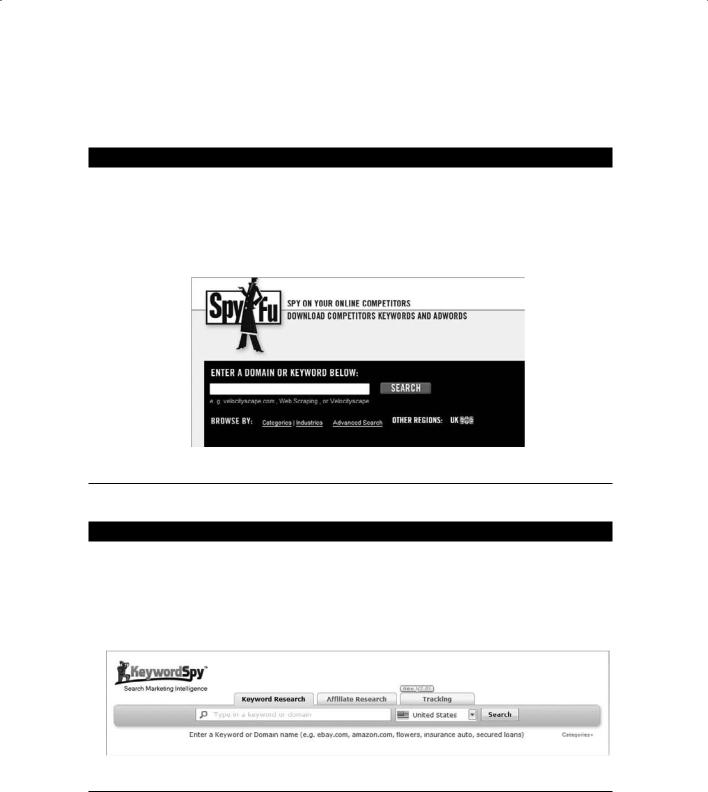
- •Acknowledgments
- •About the Author
- •Contents at a Glance
- •Contents
- •Table of Exercises
- •Introduction
- •Assessment Test
- •Answers to Assessment Test
- •Defining Ethical Hacking
- •How to Be Ethical
- •Keeping It Legal
- •Summary
- •Exam Essentials
- •Review Questions
- •Answers to Review Questions
- •Reconnaissance
- •Information-Gathering Methodology
- •Social Engineering
- •Summary
- •Exam Essentials
- •Review Questions
- •Answers to Review Questions
- •Scanning
- •Enumeration
- •Summary
- •Exam Essentials
- •Review Questions
- •Answers to Review Questions
- •The Simplest Way to Get a Password
- •Types of Passwords
- •Cracking a Password
- •Understanding Keyloggers and Other Spyware Technologies
- •Escalating Privileges
- •Understanding Rootkits
- •Hiding Files
- •Understanding Steganography Technologies
- •Summary
- •Exam Essentials
- •Review Questions
- •Answers to Review Questions
- •Trojans and Backdoors
- •Viruses and Worms
- •Summary
- •Exam Essentials
- •Review Questions
- •Answers to Review Questions
- •How a Sniffer Works
- •Sniffing Countermeasures
- •Bypassing the Limitations of Switches
- •Wireshark Filters
- •Summary
- •Exam Essentials
- •Review Questions
- •Answers to Review Questions
- •Denial of Service
- •Session Hijacking
- •Summary
- •Exam Essentials
- •Review Questions
- •Answers to Review Questions
- •How Web Servers Work
- •Types of Web Server Vulnerabilities
- •Web Application Vulnerabilities
- •Summary
- •Exam Essentials
- •Review Questions
- •Answers to Review Questions
- •SQL Injection
- •Buffer Overflows
- •Summary
- •Exam Essentials
- •Review Questions
- •Answers to Review Questions
- •Wi-Fi and Ethernet
- •Authentication and Cracking Techniques
- •Using Wireless Sniffers to Locate SSIDs
- •MAC Filters and MAC Spoofing
- •Rogue Access Points
- •Wireless Hacking Techniques
- •Securing Wireless Networks
- •Summary
- •Exam Essentials
- •Review Questions
- •Answers to Review Questions
- •Components of Physical Security
- •Understanding Physical Security
- •Physical Site Security Countermeasures
- •What to Do After a Security Breach Occurs
- •Summary
- •Exam Essentials
- •Review Questions
- •Answers to Review Questions
- •Linux Basics
- •Compiling a Linux Kernel
- •GCC Compilation Commands
- •Installing Linux Kernel Modules
- •Linux Hardening Methods
- •Summary
- •Exam Essentials
- •Review Questions
- •Answers to Review Questions
- •Types of IDSs and Evasion Techniques
- •Summary
- •Exam Essentials
- •Review Questions
- •Answers to Review Questions
- •Generating Public and Private Keys
- •Cryptography Algorithms
- •Summary
- •Exam Essentials
- •Review Questions
- •Answers to Review Questions
- •Defining Security Assessments
- •Penetration Testing
- •Pen Test Deliverables
- •Summary
- •Exam Essentials
- •Review Questions
- •Answers to Review Questions
- •Glossary
- •Index

The first step of the hacking process is gathering information on a target. Information gathering, also known as footprinting, is the process of gathering all available information about an organization. In the age of the Internet, information is available in bits and pieces from many different sources. Seemingly insignificant bits of information can be enlightening when pieced together—which is the purpose of information gathering. Footprinting can be effective in identifying highvalue targets, which is what hackers will be looking for to focus their efforts.
A hacker uses information-gathering techniques to determine organizations’ high-value targets, where the most valuable information resides. Not only does information gathering help identify where the information is located, but it also helps determine the best way to gain access to the targets. This information can then be used to identify and eventually hack target systems. Many people jump right into running hacking tools, but information gathering is critical in minimizing the chance of detection and assessing where to spend the most time and effort.
Social engineering can also be used to obtain more information about an organization, which can ultimately lead to an attack. Social engineering as an information-gathering tool is highly effective at exploiting the most vulnerable asset in an organization: the people. Human interaction and the willingness to give out information make people an excellent source of information. Good social-engineering techniques can speed up the hacking process and in most cases will yield information much more easily.
In this chapter, we’ll look at information gathering as the first step in hacking target systems.
Reconnaissance
The term reconnaissance comes from the military and means to actively seek an enemy’s intentions by collecting and gathering information about an enemy’s composition and capabilities via direct observation, usually by scouts or military intelligence personnel trained in surveillance. In the world of ethical hacking, reconnaissance applies to the process of information gathering. Reconnaissance is a catchall term for watching the hacking target and gathering information about how, when, and where they do things. By identifying patterns of behavior, of people or systems, an enemy could find and exploit a loophole.

34 Chapter 2 n Gathering Target Information
Using Reconnaissance to Gain Physical Access
Every weekday at 3 p.m. the Federal Express driver stops at the loading dock of a building where the offices of Medical Associates, Inc. are located. When the driver backs the truck up to the rear door of the building, he presses the buzzer and lets the security guard know he is at the door. Because the building’s security personnel recognize the driver— as he comes to the door every day around the same time for pickup and drop-off—they remotely unlock the door and allow the driver to enter. A hacker is watching this process from a car in the parking lot and takes note of the procedure to gain physical entry into the building.
The next day, the hacker carries a large cardboard box toward the door just as the Federal Express driver has been given entry to the building. The driver naturally holds the door for the hacker because he is carrying what appears to be a heavy, large box. They exchange pleasantries and the hacker heads for the elevator up to Medical Associates’ offices. The hacker leaves the box in the hallway of the building as he heads to his target office.
Once he reaches the front desk of the Medical Associates office, he asks to speak with the office manager whose name he previously looked up on the company website. The receptionist leaves her desk to go get the office manager, and the hacker reaches over the desk and plugs a USB drive containing hacking tools into the back of her computer. Because the computer is not locked with a password, he double-clicks on the USB drive icon and it silently installs the hacking software on the receptionist’s computer. He removes the USB drive and quickly exits the office suite and building undetected.
This is an example of how reconnaissance and understanding the pattern of people’s behavior can enable a hacker to gain physical access to a target—in this case the Medical Associates network via a Trojaned system—and circumvent security checkpoints.
Understanding Competitive Intelligence
Competitive intelligence means information gathering about competitors’ products, marketing, and technologies. Most competitive intelligence is nonintrusive to the company being investigated and is benign in nature—it’s used for product comparison or as a sales and marketing tactic to better understand how competitors are positioning their products or services. Several tools exist for the purpose of competitive intelligence gathering and can be used by hackers to gather information about a potential target.
In Exercises 2.1 through 2.3, I will show you how to use the SpyFu and KeywordSpy online tools to gather information about a target website. SpyFu and KeywordSpy will give keywords for websites. This allows you to perform some information gathering regarding a

Reconnaissance 35
website. I use these two tools because they are easy to use and completely passive, meaning a potential target could not detect the information gathering.
E x e r c i s e 2 .1
Using SpyFu
To use the SpyFu online tool to gather competitive intelligence information:
1.Go to the www.spyfu.com website and enter the website address of the target in the search field:
2.Review the report and determine valuable keywords, links, or other information.
E x e r c i s e 2 . 2
Using KeywordSpy
To use the KeywordSpy online tool to gather competitive intelligence information:
1.Go to the www.keywordspy.com website and enter the website address of the target in the search field:
2.Review the report and determine valuable keywords, links, or other information.

36 Chapter 2 n Gathering Target Information
Another useful tool to perform competitive intelligence and information gathering is the EDGAR database. This is a database of all the SEC filings for public companies.
Information can be gathered by reviewing the SEC filings for contact names and addresses. In Exercise 2.3 I will show you how to use the EDGAR database for gathering information on potential targets.
E x e r c i s e 2 . 3
Using the EDGAR Database to Gather Information
1.Determine the company’s stock symbol using Google.
2.Open a web browser to www.sec.gov.
3.On the right side of the page, click the link EDGAR Filers.
4.Click the Search For Filings menu and enter the company name or stock symbol to search the filings for information. You can learn, for example, where the company is registered and who reported the filing.
5.Use the Yahoo! yellow pages (http://yp.yahoo.com) to see if an address or phone number is listed for any of the employee names you have located.
